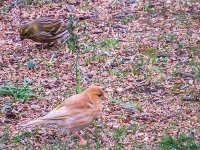Canaries are probably the most widely crossed species in captivity with crosses including (but not restricted to) Linnet, Goldfinch, Greenfinch, Redpoll, Siskin, Twite, Bullfinch, Crossbill (!), Chaffinch, Cut-throat Finch, Hooded, Pine, Black-headed Red & Black Siskins, Cut-throat, House and Purple Finches. Most of these birds occur well outside the Canary's natural range (e.g. America) They're also crossed with Serin producing fertile young. I'm not sure how often hybrids of any sort are found in the wild, if at all. (see
https://books.google.co.uk/books?id...QQ6AEIXTAN#v=onepage&q=canary crosses&f=false). They're also crossed with Serin producing fertile young.





